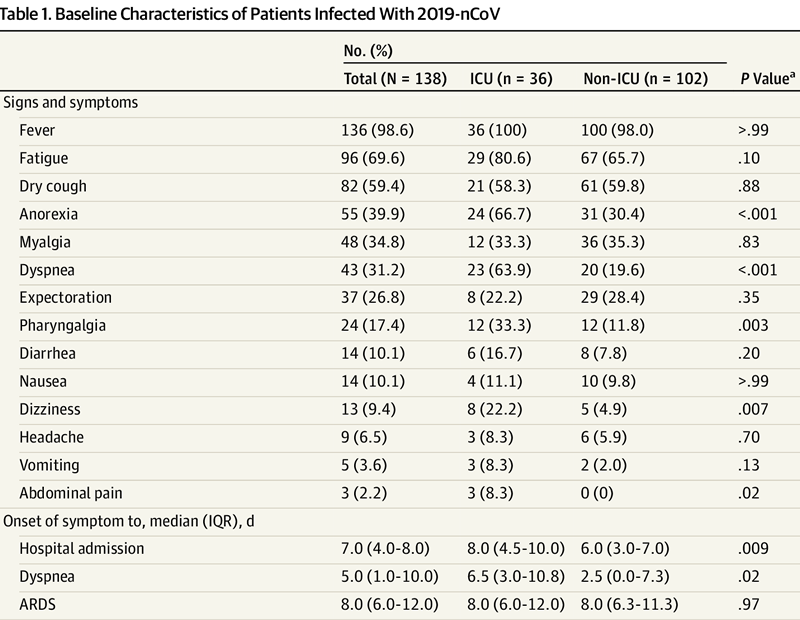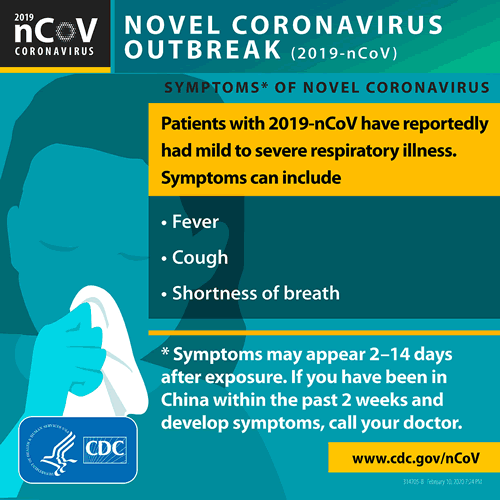3 Years Old Baby Has Cough Fluctuate Fever Breath Smell
Coronavirus Symptoms (COVID-19)
Last updated: April 24, 2:00 GMT - We will proceed to update and better this page as we gather new data and details.
People with COVID-19 take had a wide range of symptoms reported – ranging from balmy symptoms to astringent illness. These symptoms may appear 2-xiv days after exposure to the virus:
- Fever
- Coughing
- Shortness of breath or difficulty animate
- Chills
- Repeated shaking with chills
- Muscle pain
- Headache
- Sore pharynx
- New loss of taste or smell
Symptoms of Coronavirus (COVID-19) - United states Centers for Disease Control and Prevention (CDC) [1]
Typical Symptoms
COVID-xix typically causes flu-like symptoms including a fever and cough.
In some patients - particularly the elderly and others with other chronic health conditions - these symptoms can develop into pneumonia, with chest tightness, breast pain, and shortness of breath.
Information technology seems to start with a fever, followed by a dry cough.
After a week, it can pb to shortness of breath, with about xx% of patients requiring hospital treatment.
Notably, the COVID-19 infection rarely seems to cause a runny nose, sneezing, or sore throat (these symptoms take been observed in merely most 5% of patients). Sore throat, sneezing, and stuffy nose are nearly oftentimes signs of a common cold.
[back to tiptop ↑]
80% of cases are balmy
Based on all 72,314 cases of COVID-19 confirmed, suspected, and asymptomatic cases in China as of February 11, a paper by the Chinese CCDC released on February 17 and published in the Chinese Periodical of Epidemiology has establish that:
- 80.nine% of infections are mild (with influenza-like symptoms) and tin can recover at domicile.
- 13.8% are astringent, developing severe diseases including pneumonia and shortness of breath.
- iv.seven% as critical and tin include: respiratory failure, septic daze, and multi-organ failure.
- in about two% of reported cases the virus is fatal.
- Risk of death increases the older you lot are.
- Relatively few cases are seen amongst children.
[back to top ↑]
Pre-existing weather
See likewise: Death Rates by Existing Conditions
Pre-existing illnesses that put patients at higher risk:
- cardiovascular illness
- diabetes
- chronic respiratory affliction
- hypertension
That said, some otherwise healthy people do seem to develop a severe form of pneumonia afterwards being infected past the virus. The reason for this is existence investigated as nosotros try to learn more about this new virus.
[back to top ↑]
Examples of possible development of symptoms (from actual cases)
A man in his 40s in Japan:
- Day #ane: angst and muscle pain
- after diagnosed with pneumonia
A man in his 60s in Nippon:
- Day #1: initial symptoms of low-course fever and sore pharynx.
A man in his 40s in Nippon:
- Mean solar day #1: chills, sweating and angst
- Mean solar day #four: fever, muscle pain and cough
A adult female in her 70s, in Nihon:
- Day #i: 38° fever for a few minutes
- Day #two-iii: went on a omnibus tour
- Day #five: visited a medical institution
- Twenty-four hours #six: showed symptoms of pneumonia.
A woman in her 40s, in Japan:
- Day #one: low-grade fever
- 24-hour interval #2: 38° fever
- Twenty-four hour period #half-dozen: being treated at home.
A man in his 60s, in Japan:
- Day #ane: Cold
- Day #vi: Fever of 39° C. (102.2 F)
- Day #eight: Pneumonia
Some other patient, in Cathay with a history of type 2 diabetes and hypertension:
- Jan. 22: Fever and cough
- Feb. 5: Died
First death in the Philippines (a 44-yr-one-time Chinese idea to have had other pre-existing health conditions):
- Jan. 25: Fever, cough, and sore throat (hospitalized)
- Developed severe pneumonia
- Feb. ii: Died
[dorsum to top ↑]
How long do symptoms last?
Using available preliminary data, the Study of the WHO-China Articulation Mission published on February. 28 by WHO, [v] which is based on 55,924 laboratory confirmed cases, observed the following median time from symptoms onset to clinical recovery:
- mild cases: approximately 2 weeks
- severe or disquisitional disease: 3 - 6 weeks
- time from onset to the development of severe disease (including hypoxia): 1 week
Amid patients who have died, the time from symptom onset to upshot ranges from 2 - 8 weeks.
[back to top ↑]
Symptoms observed in hospitalized patients with COVID-19
Below nosotros list the symptoms, with percentages representing the proportion of patients displaying that symptom, as observed in hospitalized patients tested and identified every bit having laboratory-confirmed COVID-19 infection. These findings refer to hospitalized patients, therefore generally representing serious or critical cases. The majority of cases of COVID-nineteen (about eighty%) is mild.
Findings from the Wang et al study published on JAMA and based on 138 hospitalized patients [two]
| Common symptoms included: | |
| Fever | 98.six% |
| Fatigue | 69.6% |
| Dry cough | 59.iv% |
The median time observed:
- from first symptom to → Dyspnea (Shortness of breath) = v.0 days
- from first symptom to → Infirmary admission = 7.0 days
- from first symptom to → ARDS (Acute Respiratory Distress Syndrome) = 8.0 days (when occurring)
Full list of symptoms from the Wang study:

From: Clinical Characteristics of 138 Hospitalized Patients With 2019 Novel Coronavirus–Infected Pneumonia in Wuhan, China - JAMA, Wang et al., February seven, 2020
Findings from the Huang et al study published on The Lancet and based on 41 hospitalized patients [3]
| COMMON SYMPTOMS | |
| Fever | 98% |
| Cough | 76% |
| Myalgia (muscle hurting) | 44% |
| LESS Common SYMPTOMS: | |
| Sputum production | 28% |
| Headache | 8% |
| Haemoptysis | 5% |
| Diarrhea | three% |
Findings from the Chen et al study published on The Lancet and based on 99 hospitalized patients [iv]
| Signs and symptoms at access | ||
| Fever | 83% | |
| Cough | 82% | |
| Shortness of jiff | 31% | |
| Muscle ache | 11% | |
| Confusion | 9% | |
| Headache | 8% | |
| Sore pharynx | 5% | |
| Rhinorrhoea (runny nose) | 4% | |
| Chest hurting | 2% | |
| Diarrhea | 2% | |
| Nausea and vomiting | i% | |
| More one sign | xc% | |
| Fever, coughing, | fifteen% | |
[dorsum to superlative ↑]
Data on Coronavirus Symptoms from Government Wellness Officials
Canada Public Health Agency
The Canadian PHAC section defended to the 2019 novel coronavirus states that:
- You may have piffling to no symptoms.
- Y'all may not know yous have symptoms of COVID-xix because they are similar to a cold or flu.
- Symptoms may take upwards to 14 days to announced after exposure to the virus. This is the longest known infectious period for this virus.
Symptoms take included:
- fever
- coughing
- difficulty breathing
- pneumonia in both lungs
In severe cases, infection tin can lead to expiry.
UK Government and NHS
The U.k. National Health Service (NHS) section defended to Coronavirus (2019-nCoV) lists the following as the main symptoms of coronavirus:
- a cough
- a loftier temperature
- shortness of jiff
The GOV.Britain novel coronavirus guidance for the public folio says:
- Typical symptoms of coronavirus include fever and a cough that may progress to a severe pneumonia causing shortness of breath and animate difficulties.
The GOV.Great britain clinical guidance on Novel coronavirus (2019-nCoV): epidemiology, virology and clinical features notes that:
- Fever, cough or chest tightness, and dyspnoea are the main symptoms reported. While most cases report a balmy illness, severe are also existence reported, some of whom require intensive care.
Australian Government
The Australian Government Section of Health informs that symptoms can range from balmy disease to pneumonia, adding that some people will recover easily, while others may get very sick very rapidly. Co-ordinate to their list of novel coronavirus symptoms, people may feel:
- fever
- flu-like symptoms such as coughing, sore throat and fatigue
- shortness of jiff
Us Centers for Illness Control and Prevention
The CDC has published the post-obit infographic on its Symptoms of Novel Coronavirus (2019-nCoV):

World Health Organization
The WHO has issued an acting guidance on the clinical direction of suspected cases in which it says that
- "nCoV may present with balmy, moderate, or severe disease; the latter includes astringent pneumonia, ARDS, sepsis and septic shock."
[back to top ↑]
Coronavirus Worldometer Sections:
- Coronavirus Update
- Case statistics and graphs
- Death statistics and graphs
- Mortality Charge per unit
- Incubation Period
- Age, Sex, Existing Condition
- Symptoms
- Countries with cases: basic list - detailed list
Sources
- Symptoms of Novel Coronavirus (2019-nCoV) - United States Centers for Illness Control and Prevention (CDC)
- Clinical Characteristics of 138 Hospitalized Patients With 2019 Novel Coronavirus–Infected Pneumonia in Wuhan, China - JAMA, Wang et al., Feb 7, 2020
- Clinical features of patients infected with 2019 novel coronavirus in Wuhan, Communist china - Huang et al., The Lancet. January 24, 2020
- Epidemiological and clinical characteristics of 99 cases of 2019 novel coronavirus pneumonia in Wuhan, Red china: a descriptive written report - Chen et al, The Lancet, January 30, 2020
- Report of the WHO-Mainland china Articulation Mission on Coronavirus Disease 2019 (COVID-nineteen) [Pdf] - World Health Organization, Feb. 28, 2020
Source: https://www.worldometers.info/coronavirus/coronavirus-symptoms/
0 Response to "3 Years Old Baby Has Cough Fluctuate Fever Breath Smell"
Post a Comment